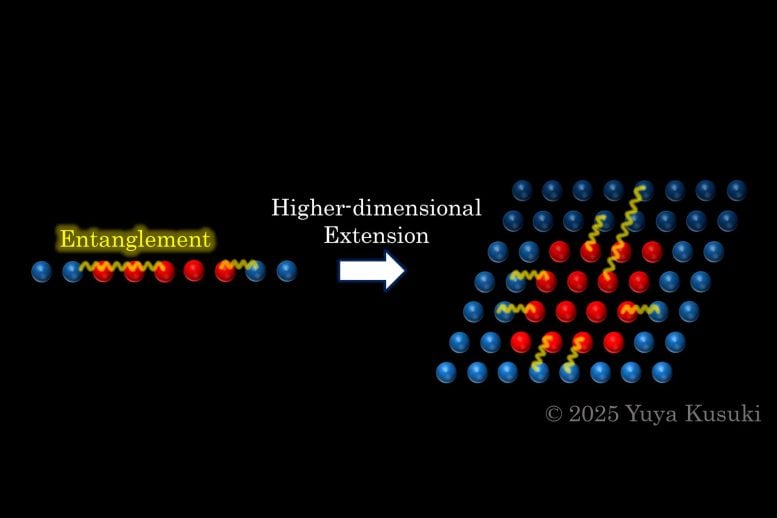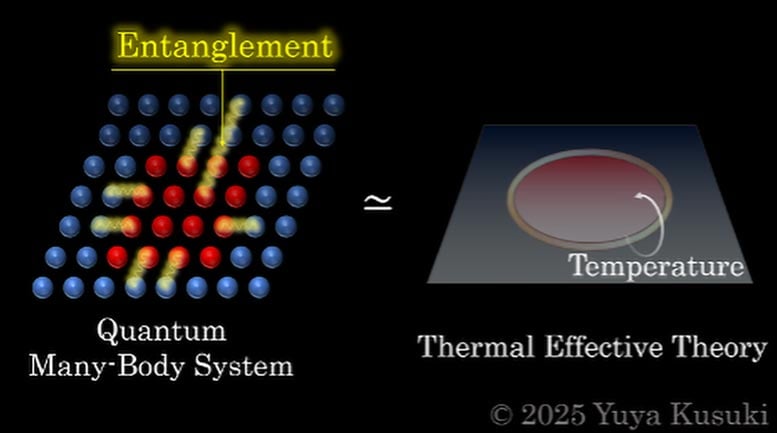
Scientists uncovered universal laws of entanglement in any dimension. The results strengthen links between particle physics, quantum theory, and gravity.
A group of theoretical physicists has shown that quantum entanglement obeys universal principles in every dimension by applying thermal effective theory. Their findings were recently published in the journal Physical Review Letters, where the paper was selected as an Editors’ Suggestion.
“This study is the first example of applying thermal effective theory to quantum information. The results of this study demonstrate the usefulness of this approach, and we hope to further develop this approach to gain a deeper understanding of quantum entanglement structures,” said lead author and Kyushu University Institute for Advanced Study Associate Professor Yuya Kusuki.
Quantum entanglement and Rényi entropy
In classical physics, particles that are far apart act independently. In contrast, quantum physics shows that two particles can remain strongly correlated even at great distances, a phenomenon known as quantum entanglement. This effect is central to quantum technologies such as quantum computing and quantum communication, making its study essential for both theoretical insight and practical applications.

One of the main tools for characterizing entanglement is the Rényi entropy, which measures the complexity of quantum states and how information is distributed. It plays a key role in classifying quantum states, evaluating whether complex quantum systems can be simulated, and is also widely used in theoretical research on the black hole information loss paradox and quantum gravity.
Despite its importance, uncovering the structure of quantum entanglement remains a major challenge for both physics and quantum information science. Most investigations so far have been restricted to (1+1)-dimensional models, meaning one spatial dimension plus time. Extending this work to higher dimensions has proven much more complex.
A team led by Yuya Kusuki at the University of Tokyo’s Kavli Institute for the Physics and Mathematics of the Universe (Kavli IPMU, WPI), together with Caltech Professor Hirosi Ooguri and researcher Sridip Pal, has now demonstrated that quantum entanglement exhibits universal patterns even in higher dimensions. They achieved this by adapting theoretical methods originally developed in particle physics to the study of quantum information.
Applying the thermal effective theory
The research team focused on the thermal effective theory, which has recently led to major advances in the analysis of higher-dimensional theories in particle physics. This is a theoretical framework designed to extract universal behavior from complex systems, based on the idea that observable quantities can often be characterized by only a small number of parameters.
By introducing this framework into quantum information theory, the team analyzed the behavior of Rényi entropy in higher-dimensional quantum systems. Rényi entropy is characterized by a parameter known as the replica number.
The team demonstrated that, in the regime of small replica number, the behavior of the Rényi entropy is universally governed by only a few parameters, such as the Casimir energy, a key physical quantity within the theory. Furthermore, by leveraging this result, the team clarified the behavior of the entanglement spectrum in the region where its eigenvalues are large.

They also investigated how universal behavior changes depending on the method used to evaluate the Rényi entropy. These findings hold not only in (1+1) dimensions, but in arbitrary spacetime dimensions, marking a significant step forward in the understanding of quantum entanglement structures in higher dimensions.
The next step for the researchers is to further generalize and refine this framework. This work represents the first demonstration that thermal effective theory can be effectively applied to the study of quantum entanglement structures in higher dimensions, and there remains ample room to further develop this approach. By improving the thermal effective theory with quantum information applications in mind, researchers could gain a deeper understanding of quantum entanglement structures in higher-dimensional systems.
On the applied side, the theoretical insights gained from this research may lead to improvements in numerical simulation methods for higher-dimensional quantum systems, propose new principles for classifying quantum many-body states, and contribute to a quantum-information-theoretic understanding of quantum gravity. These developments hold promise for broad and impactful future applications.
Reference: “Universality of Rényi Entropy in Conformal Field Theory” by Yuya Kusuki, Hirosi Ooguri and Sridip Pal, 5 August 2025, Physical Review Letters.
DOI: 10.1103/fsg7-bs7q
This research was supported in part by the U.S. Department of Energy, Office of Science, Office of High Energy Physics, under Award Number DE-SC0011632 and by the Walter Burke Institute for Theoretical Physics at Caltech. Hirosi Ooguri is also supported in part by the Simons Investigator Award (MP-SIP-00005259) and by JSPS Grants-in-Aid for Scientific Research 23K03379. His work was performed in part at the Kavli Institute for the Physics and Mathematics of the Universe at the University of Tokyo, which is supported by the World Premier International Research Center Initiative, MEXT, Japan, at the Kavli Institute for Theoretical Physics (KITP) at the University of California, Santa Barbara, which is supported by grant NSF PHY-2309135, and at the Aspen Center for Physics, which is supported by NSF grant PHY-1607611. Yuya Kusunoki is also supported by the INAMORI Frontier Program at Kyushu University and JSPS KAKENHI Grant Number 23K20046.
Never miss a breakthrough: Join the SciTechDaily newsletter.
13 Comments
On the applied side, the theoretical insights gained from this research may lead to improvements in numerical simulation methods for higher-dimensional quantum systems, propose new principles for classifying quantum many-body states, and contribute to a quantum-information-theoretic understanding of quantum gravity. These developments hold promise for broad and impactful future applications.
VERY GOOD.
Please ask researchers to think deeply:
1. What are the quantum?
2. Where does quantum come from?
3. Where does the singularity come from?
4. Where does the energy of the singularity explosion come from?
5. Isn’t space everywhere?
6. Where do things in space come from?
7. Why does physics today ignore the ubiquity of space and instead search for imaginary God particles everywhere?
8. Isn’t space a physical entity?
9.As a physical entity, what physical properties should space possess?
10. If the space does not have physical entity properties, please inform the public where the physics experiment was conducted?
An entire generation has been severely misled, poisoned and fooled by so-called peer-reviewed publications. In today’s physics, the so-called peer-reviewed journals—including Physical Review Letters, Nature, Science, and others—stubbornly insist on and promote the following:
1. Even though θ and τ particles exhibit differences in experiments, physics can claim they are the same particle. This is science.
2. Even though topological vortices and antivortices have identical structures and opposite rotational directions, physics can define their structures and directions as entirely different. This is science.
3. Even though two sets of cobalt-60 rotate in opposite directions and experiments reveal asymmetry, physics can still define them as mirror images of each other. This is science.
4. Even though vortex structures are ubiquitous—from cosmic accretion disks to particle spins—physics must insist that vortex structures do not exist and require verification. Only the particles that like God, Demonic, or Angelic are the most fundamental structures of the universe. This is science.
5. Even though everything occupies space and maintains its existence in time, physics must still debate and insist on whether space exists and whether time is a figment of the human mind. This is science.
6. Even though space, with its non-stick, incompressible, and isotropic characteristics, provides a solid foundation for the development of physics, physics must still insist that the ideal fluid properties of space do not exist. This is science.
And so on.
The so-called peer-reviewed journals—including Physical Review Letters, Nature, Science, and others openly define differences as sameness, sameness as differences, existence as nonexistence, and nonexistence as existence—all while deceiving and fooling the public with so-called “impact factors (IF),” never knowing what shame is.
The universe is not a God, nor is it merely Particles. Moreover, it is not Algebra, Formulas, or Fractions. The universe is the superposition, deflection, entanglement, and locking of spacetime vortex geometries, the interaction and balance of topological vortices and their fractal structures. Topological invariants are the identical intrinsic properties between two isomorphic topological spaces. Different civilizations may create distinct mathematical codes or tools to describe the universality and specificity of these topological invariants under different physical laws.
Topology provides stability blueprints, but specific physics (spatial features, gravitational collapse, fluid viscosity, quantum measurement) dictates vortex generation, evolution, and decay. If researchers are interested in this, please visit https://zhuanlan.zhihu.com/p/1933484562941457487 and https://zhuanlan.zhihu.com/p/1925124100134790589.
I think this might top the list as one of the wildest posts you’ve had Bao. Quite the accomplishment. I’ve always wondered if you actually believe what you say, but after all of this, I think you might actually.
Please don’t post links to random notes.
As for the rest of that comment, “What can be asserted without evidence can also be dismissed without evidence.”
Quantum entanglement exists because that is the method used to entangle a spirit with a body. The spirit is then able to experience first hand everything the physical body experiences. Quantum entanglement will be used by the antichrist to make all people who take the mark of the beast become enslaved and one with the antichrist. When Satan indwells the antichrist, that means humanity with the mark becomes one with Satan. Humanity will have one entangled mind dominated by Satan himself. Believe it or not, but time will tell.
LOL omg what? This is an amazing comment, hilarious. Quantum woo squared over here.
Thieves. I wrote about this IN MARCH and have been ignored. Y’all were still stuck on dark matter. Egos knows no bounds
What? I also read about this a while ago. What does ego have to do about anything lol? The STD comment section is always gold, I swear.
The following true statement is causing a lot of misinformation: “…quantum physics shows that two particles can remain strongly correlated EVEN AT GREAT DISTANCES, a phenomenon known as quantum entanglement.”
If you’re going to mention distance, please clarify that distances are not relative because there is no communication between the entangled particles. This is why distance doesn’t matter. Changes to one do not cause a change in the other, which is what the above truth leads people to believe falsely. It is better to say that they are part of the same wavefunction, and revealing a property about one reveals a property about the other.
It is important to note that those measured entangled properties are not set when their initial entanglement occurs, it’s still a random variable that is defined at measurement, so the question goes, if particle 1 can only ever be the opposite of 2, how do they do that? The simple explanation is that wave functions are nonlocal and the combined wave function really did extend between those two distant particles which were both updated the same instant either one was measured.
The wavefunction appends to the system and the measurement device, and the measurement redirects its peaks. But the peaks travel in a complex multidimensional probability space, so the nature of the particles are indefinite before that – they don’t “do” anything.
https://profmattstrassler.com/2025/03/10/do-quantum-wave-functions-collapse/
https://profmattstrassler.com/2025/03/31/quantum-interference-5-coming-unglued/
https://profmattstrassler.com/2025/04/14/is-superposition-really-an-or/
The simpler yet explanation for the asked about randomness is that relativistic quantum field theory has to handle spin conservation without preferring reference frames. Then the stochasticity of observation is a special relativity effect with the same non-familiarity as time dilation and length contraction.
Stuckey, W.M., Silberstein, M., McDevitt, T. et al. Answering Mermin’s challenge with conservation per no preferred reference frame. Sci Rep 10, 15771 (2020). https://doi.org/10.1038/s41598-020-72817-7
“relativistic quantum field theory has to handle spin conservation” for every field, as they all have particles with some spin value (including examples of zero spin).
Thanks to Mr. Kenny Bellew . Even we accept the two particles of the same wavefunction correlated at Great Distances, further study will make us to justify the varied entanglement with reference to the different environmental (medium )parameters prevailing along the distance between them.
The paper is on conformal field theory, not physical fields.